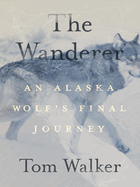
 Tom Walker (Wild Shots; Alaska Wildlife; The Seventymile Kid), an accomplished photographer, author and longtime Alaskan, turns his naturalist expertise to a single individual animal emblematic of a larger story in The Wanderer: An Alaska Wolf's Final Journey.
Tom Walker (Wild Shots; Alaska Wildlife; The Seventymile Kid), an accomplished photographer, author and longtime Alaskan, turns his naturalist expertise to a single individual animal emblematic of a larger story in The Wanderer: An Alaska Wolf's Final Journey.
"On the northern frontier of Canada and Alaska sprawls a wilderness largely devoid of human imprint." Walker outlines his subjects broadly: the land, its natural and human histories, flora and fauna and variations in land use over centuries. He transports his readers to early November of 2010, to the slopes above Copper Creek, where two gray wolves roam: an older female, already collared as Wolf 227, and her younger male companion. Biologists spot them from a helicopter and descend to tag him as Wolf 258, although Walker will call him the Wanderer (with some protest from scientists, who prefer the impersonal numbering system over names, even the archetypal). Over the following 11 months, GPS tracking shows the Wanderer traveling nearly 3,000 miles, earning his nickname in a lengthy quest for prey, territory, and a mate.
Walker narrates this journey in detail, with lyricism and a clear love for the land and life forms he describes, using his informed imagination to provide specifics where the GPS collar cannot. "The Coleen tumbles through treeless highlands that in summer are resplendent with wildflowers. Between storms, the crystalline waters rush lyrically over the cobblestones.... In summer, lupine and fireweed bloom in willow thickets alive with breeding songbirds and ptarmigan." In Walker's telling, with the benefit of expert biologists' opinions, the Wanderer makes repeated inexplicable decisions: to turn away from abundant prey and to move into areas of greater risk from humans or other wolves--although he will generally be lucky in avoiding threats. Through his choices and movements, readers consider broader questions about habitat, climate change, predator/prey relationships, and the rights of human vs. animal hunters. (Walker relates the history of predator control policies in Alaska and throughout the U.S.)
Stunning photographs and essential maps help readers follow the Wanderer's ramblings. Intermingled with his meticulous account of the wolf's wanderings, Walker handles related subjects: geology and natural history; Alaska politics; remarkable stories of animal and human life in the Arctic; pack dynamics; and the changing habits and habitats of species the wolf interacts with, including caribou, grizzly bears, Dall sheep, Arctic ground squirrels, moose, and muskox. The Wanderer is a deeply enjoyable example of creative nonfiction and nature writing: literary, lovely, meditative in its pacing, informative and clear. --Julia Kastner, librarian and blogger at pagesofjulia
Shelf Talker: This unforgettable portrait and travelogue of an individual Alaska gray wolf gorgeously and thoughtfully illuminates issues for the species and for all Arctic wildlife.

